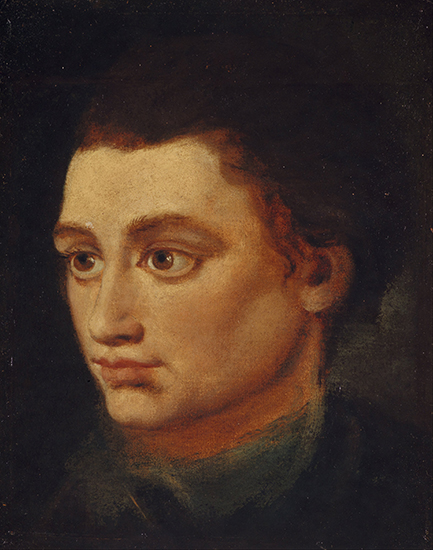18.3 Distinctive characteristics and Scots as a language for poetry
When asked what he thought Robert Burns’ best single line of poetry was, Hugh MacDiarmid said that it was the line, ‘Ye are na Mary Morrison…’ from the song, ‘Mary Morrison [Tip: hold Ctrl and click a link to open it in a new tab. (Hide tip)] ’. In context, the meaning is simple enough: the speaker, a young man at a dance, is looking around for the woman he has set his heart on and doesn’t see her. The women he sees are fine and good but none of them are Mary Morrison.
Norman MacCaig said he thought MacDiarmid’s choice was surprising, since he’d expected MacDiarmid to quote a politically charged line, such as ‘A man’s a man for a’ that…’ But MacDiarmid’s choice was deeply political in one important sense. He wrote elsewhere that he was committed to bringing to an end the idea of ‘superiority’ attached to one language and imposed over and above another. He was thinking not only of Scots and Gaelic but all the languages of the world which had been threatened, and some made extinct, by colonial conquest. He wrote: ‘All dreams of imperialism must be exorcised, including linguistic imperialism / Which sums up all the rest.’ (MacDiarmid, H. 1955.)
In this light, his preference for that line of Burns takes on a powerful significance, because there is all the difference in the world between saying ‘You are not Mary Morrison’ and ‘Ye are na Mary Morrison.’ Those two tiny, seemingly unimportant words ‘Ye’ and ‘na’ set the tone for the whole line; they combine regret, haunted urgency in the search for the beloved, loss and regret at not seeing her or finding her there, and a definite, optimistic sense of preference: other young women may indeed be fine, attractive, bright in various ways and beautiful to the eyes of various beholders, but none of them is the woman for him.
It’s in that vernacular, colloquial, intimate yet objective tone that the poetry of the line resides.

Burns (1759–96) wrote his poems and songs in the culmination of the work of a number of writers which opened the ground for him, both in terms of a reading public in Edinburgh, who were well-educated in Scottish poetic tradition and eager for new work, and in terms of a broader public keenness for engagement with Scots vernacular poetry, first in Burns’ native Ayrshire, then further afield.
The key figure in this story is Allan Ramsay (1686–1758), whose two-volume anthology The Ever Green (1724) drew upon the Bannatyne Manuscript of poems from the 15th and 16th centuries collected by George Bannatyne in the 16th century. When Ramsay published his anthology in the 18th century, it reintroduced poets such as Dunbar and Henryson to a new readership.
The immediate successor in this story is Robert Fergusson (1750–74), whom Burns described as his ‘elder brother in misfortune, by far my elder brother in the Muse’: that is, Burns recognised that Fergusson, in his poverty and ultimate breakdown and incarceration in an asylum for the insane, was in more desperate conditions than himself but that nonetheless, he was as great or even a greater poet. Certainly, Burns gained from the writing and cultural presence these two predecessors had made.
In the 19th century, poetry in Scots was sometimes found in the newspapers and periodicals of the cities, particularly Glasgow and Aberdeen. Tom Leonard’s anthology Radical Renfrew collects many of these poems of protest, demanding social redress. As the majority of the population of Scotland centred in the cities (especially industrial Glasgow) the vernacular speech idioms and literary forms that had been familiar and fluent in village politics and rural life were applied in city contexts. Important poets of this era included David Webster (1787–1837), Thomas Burnside (1822–79), and John Barr (1822–92) and Jessie Russell (1850–1923) both of whom emigrated to New Zealand.
After the First World War, the Scottish Literary Renaissance led by Hugh MacDiarmid foregrounded poetry in Scots, with the long, book-length poem ‘A Drunk Man Looks at the Thistle’ (1926) galvanising the literary scene in its radical engagement with adult themes and ideas that most nineteenth-century Scots language poetry had been neglecting.
MacDiarmid took on an international range of reference in the priorities of politics and the economy described by Marx, ideas of psychology and sexuality explored by Freud, concepts of power and the refusal of a ‘slave-mentality’ affirmed by Nietzsche. In this, he had much in common with his contemporaries, Ezra Pound and T.S. Eliot, but he delivered his most searching expositions of these ideas in poems written in vernacular Scots.
MacDiarmid’s younger Scottish contemporary, William Soutar (1898–1946), was equally dedicated to writing poems in Scots, both poems for adults such as MacDiarmid had pioneered, and brilliantly written poems for children, ‘Bairnrhymes’, riddles and ‘Whigmaleeries’.
These poets regenerated Scots poetry in the 18th, and then again emphatically in the 20th century. The extent to which Scots is available to anyone in the 21st century through online sources as well as freely accessible archives means that the rich history of the subject can be more fully explored than ever before. At the same time, it will always be necessary to enhance and complement our study of the subject by experiencing Scots as a living language, which means venturing into the world beyond libraries and universities.
Having acquired some knowledge and experience of how Scots is spoken currently, it is equally necessary to return to our opening point, that words, language, forms of expression are different in poems than they are in everyday speech. This unit has done no more than introduce some of the range of different poetic forms and moments of urgency through history in which they have found expression.
Activity 8
In the penultimate activity of this unit, you will note your views on one of the aspects you have come across here: The distinctive or ‘untranslatable’ characteristics of poetry in Scots.
- Go through the work you have done in this unit again and think about the poem that has captured you most of all, especially in terms of:
- a. the way in which the Scots language was used to make an impression on you as a reader/listener. Think also of reasons for your choice.
- b. whether you think the message of the poem could not have been the same had it been written in English or Standard Scottish English – linking to the idea of distinctive or ‘untranslatable’ characteristics of poetry in Scots.
- c. your favourite line/phrase/word(s) used in the poem.
- d. maybe also the link between language and the theme of the poem.
- Then write a short paragraph expressing your thoughts on the points listed above. You may even want to write this short paragraph in Scots. Below is some guidance on how to approach this, especially if you are not a Scots speaker.
Answer
This is a model answer. Your answer will be different.
The poem that moved me most was Gerda Stevenson’s ‘The Abdication of Mary Queen of Scots’. I was struck be the power of emotion here, by how Mary was presented as a strong woman, even in her weakest hour. Had the poem been written in English, this compelling message would have been significantly weakened. The Scots language gives Mary authenticity, it is at the heart of her sense of identity. Scots is the most appropriate ‘tool’ to express her powerful emotions.
My favourite lines are the ones reflecting her anger, deep sadness and the power she still holds through not submitting her mind to her abductors are:
O, I could run rings roon ilka yin o ye in Greek an aa,
as weel’s ma bonnie French, but ye’re naethin, naethin noo,
juist ghaists
Scots language is closely related to the theme of the poem, power. This happens in two ways, Scots is used as the language of the oppressed, those not in power, but also as the language of people with a strong sense of identity who resist the power of the establishment
Writing in Scots
You have now come across a wide range of texts in different regional variations of Scots and have:
- become acquainted with the way in which the language is ‘put together’ into sentences and texts.
- also studied key grammatical features of Scots, which are tools for forming longer utterances in the language.
- throughout this course assembled your own record of Scots vocabulary, ideally noting examples of how the words you listed are used in context.
These three aspects will now help you put together your own written Scots. Instead of writing in English and then translating into Scots, we suggest you start writing in Scots straightaway.
If you are new to the language, start small, even with just bullet points. Then go back to texts in Scots you have read in the course and explore how writers have used words and phrases to link shorter bits of sentences to create longer and more complex ones.
Then, step by step, you are on your way to produce your own written Scots – and do not worry about mixing words from different Scots dialects. Remember that you have learned that Scots is a living language that is shaped by its users who pick and choose their own repertoire of vocabulary.
18.2 A brief and very concise history of poetry in Scots
